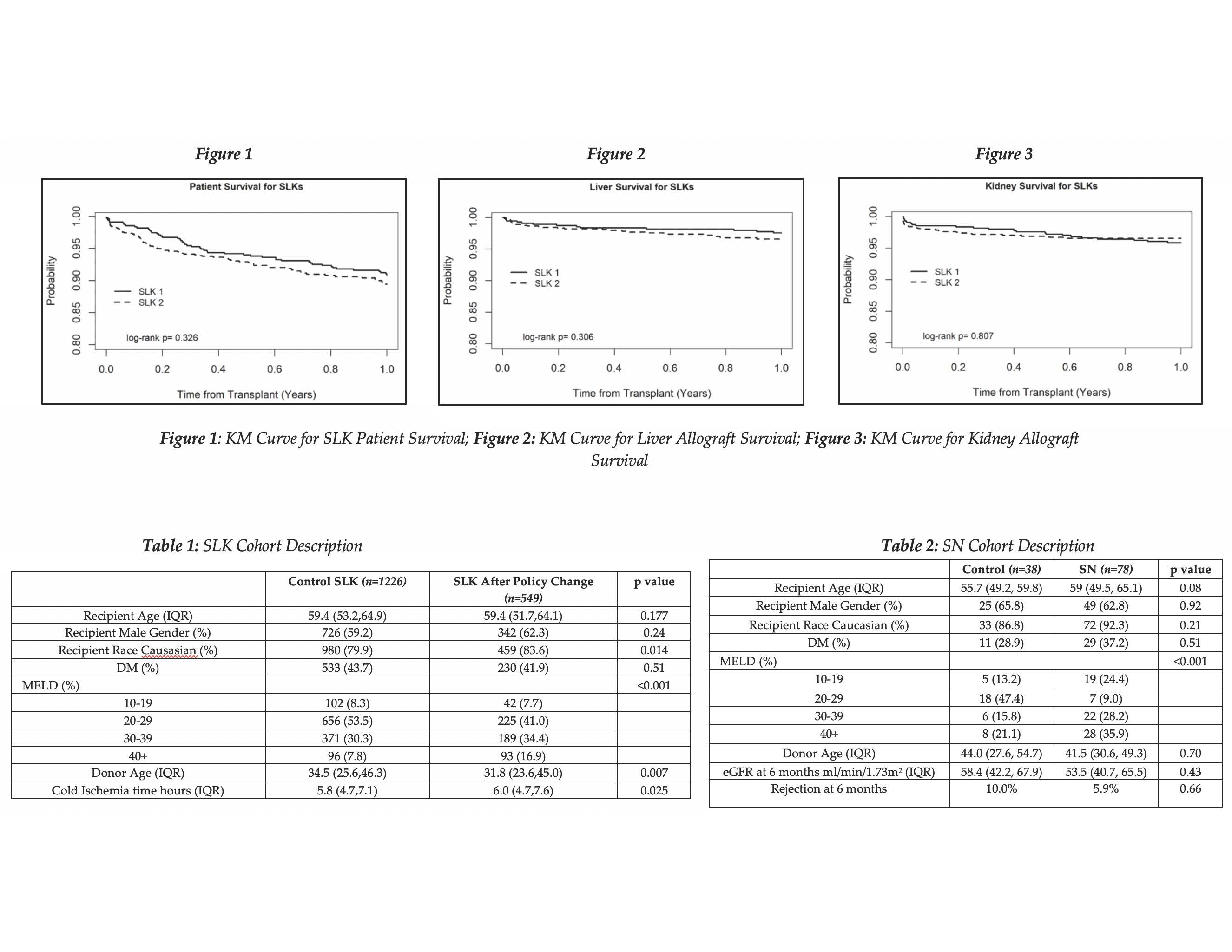Simultaneous Liver and Kidney Transplant Outcomes after “Safety Net” Policy Change
1University of Minnesota, Minneapolis, MN, 2Surgery, University of Minnesota, Minneapolis, MN
Meeting: 2020 American Transplant Congress
Abstract number: 258
Keywords: Kidney/liver transplantation, Liver grafts, Public policy, Safety
Session Information
Session Name: Kidney Issues in Liver Transplantation
Session Type: Oral Abstract Session
Date: Saturday, May 30, 2020
Session Time: 3:15pm-4:45pm
 Presentation Time: 3:27pm-3:39pm
Presentation Time: 3:27pm-3:39pm
Location: Virtual
*Purpose: Criteria for listing for Simultaneous Liver and Kidney (SLK) transplant changed on August 10, 2017. These changes were implemented to standardize the criteria for SLK and provide for a “Safety Net” (SN) kidney transplant option for liver transplant alone candidates who had low GFR or dialysis dependence after liver transplant. We compared the outcomes of SLK and SN to historical controls.
*Methods: Using the SRTR database, we compared a cohort of 549 SLK and 78 SN transplants on or after August 11, 2019 to a historical control cohort of 1226 SLK and 38 Kidney after Liver (KAL) from 1st January 2004 to 1st January 2015. A buffer from 1st January 2015 to 11th August 2019 was chosen as listing behaviors that may have changed in anticipation of the rollout of the new policy. KAL transplants were restricted to deceased donor kidney transplants that occurred 60 – 365 days after liver transplant to mirror current SN policy.
*Results: Kaplan Meier (KM) curves for patient survival, liver and kidney survival are shown in Figures 1, 2 and 3. There were no significant differences before and after the policy change, despite the increase in the MELD score after the change. Table 1 shows the characteristics of the cohort. The significant differences were increase in white recipients 83.6% compared to 79.9% (p=0.014); an increase in cold ischemic time from 6 hours (4.71; 7.60) compared to 5.75 hours (4.65; 7.1) (p=0.025); donor age was lower 31.8 (23.6; 45) compared to 34.5 (25.6; 46.3) (p=0.007); an increase MELD after policy change with p<0.001 for trend. We compared SN to historical deceased donor kidney after liver transplant with cohort characteristics listed in Table 2. MELD at liver transplant was significantly higher in the SN cohort p<0.001 for trend. There were three deaths in the SN cohort and none in the historical control group (p=0.10). There were no graft failures in either group in the follow up period. There were no significant differences in rejection at six months with 5.9% in the SN cohort and 10% in control (p=0.66). eGFR at six months was 53.5 ml/min/1.73 m2 in the SN group and 58.4 ml/min/1.73 m2 (p=0.42).
*Conclusions: Policy changes governing listing for SLK have resulted in no significant changes in patient or graft survival. SN kidney outcomes are similar to historical controls for eGFR, rejection at six months as well as patient and graft survival.
To cite this abstract in AMA style:
Keys D, Leventhal T, Jackson S, Riad S, Spong R, Matas A, Rao J. Simultaneous Liver and Kidney Transplant Outcomes after “Safety Net” Policy Change [abstract]. Am J Transplant. 2020; 20 (suppl 3). https://atcmeetingabstracts.com/abstract/simultaneous-liver-and-kidney-transplant-outcomes-after-safety-net-policy-change/. Accessed December 14, 2025.« Back to 2020 American Transplant Congress

